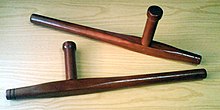Tonfa


The tonfa (Okinawan: トンファー tonfā, Chinese: 柺; pinyin: guǎi lit. old man's staff / "crutch"), also spelled as tongfa or tuifa, also known as T-baton[1] is a melee weapon best known for its role in the armed component of Okinawan martial arts. It consists of a stick with a perpendicular handle attached a third of the way down the length of the stick, and is about 15–20 inches (380–510 mm) long.[2] It was traditionally made from red or white oak and wielded in pairs.[3] The tonfa is believed to have originated in either China or Southeast Asia where it is used in the respective fighting styles. A similar weapon called the mai sok san is used in Krabi-krabong and tomoi.
History[]
Although the tonfa is most commonly associated with the Okinawan martial arts, its origin is heavily debated. One of the most commonly cited origins is China, although origins from Indonesia to Thailand are also possible.[4][5][6] Although modern martial artists often cite that the tonfa derives from a millstone handle used by peasants, [3] martial arts in Okinawa were historically practised by the upper classes who imported martial arts from China and elsewhere, and it is likely that the weapon was imported from outside Okinawa. The Chinese and Malay words for the weapon (guai and topang respectively) literally mean "crutch", which may suggest the weapon originating from such device. In Cambodia and Thailand a similar weapon is used consisting of a pair of short clubs tied onto the forearms, known in Thai as mai sok and in Khmer as staupe. In Thailand and Malaysia the mai sok often has a similar design to the tonfa, with a perpendicular handle rather than being tied on. This weapon might be the original version of the tonfa.[3][4]

Usage[]
The tonfa measures about three centimeters past the elbow when gripped.[6] There are three grips, honte-mochi (natural), gyakute-mochi (reverse) and tokushu-mochi (special). The natural grip places the handle in the hand with the long arm resting along the bottom of the forearm. This grip provides protection or brace along one's forearms, and also provides reinforcement for backfist, elbow strikes, and punches. In use, the tonfa can swing out to the gyakute grip for a strike or thrust. Martial artists may also flip the tonfa and grab it by the shaft, called tokushu-mochi. This allows use of the handle as a hook in combat, similar to the kama (sickle).[5][6] This grip is uncommon but is used in the kata Yaraguwa.[6]
Many modern law enforcement departments use side-handle batons, a weapon derived from the tonfa, to augment the less-lethal tools of an officer.
See also[]
- Okinawan weapons
References[]
- ^ "Rare Kung Fu Weapons | Specialty Weapons".
- ^ "Weapons – Tonfa". Lyon Karate. Retrieved 29 May 2017.
- ^ a b c "Tonfa history". Tonfa.org. Archived from the original on 14 June 2017. Retrieved 29 May 2017.
- ^ a b David (11 February 2009). "A Brief History of the Tonfa". japanesejujitsu.org. Archived from the original on 15 January 2018. Retrieved 29 May 2017.
- ^ a b "History". cs.canisius.edu. Retrieved 29 May 2017.
- ^ a b c d "Tonfa". RKAGB. 4 June 2016. Retrieved 29 May 2017.
Further reading[]
- Robert Paturel and Alain Formaggio, Tonfa sécurité, Chiron éditeur, 2001. OCLC 421954363. ISBN 978-2-7027-0667-1.
- Blunt weapons
- Weapons of Okinawa